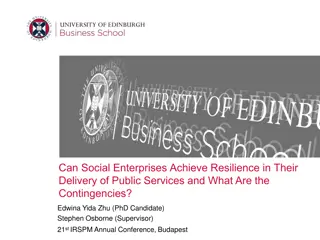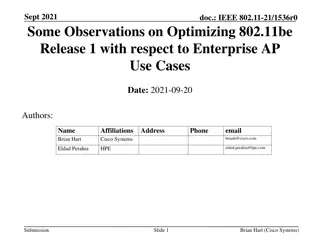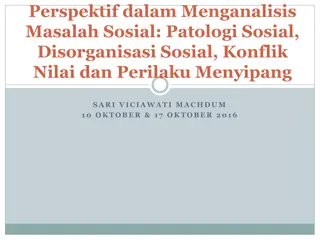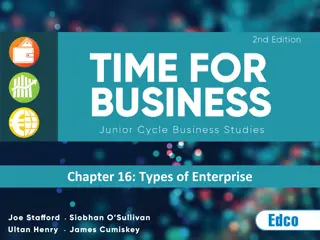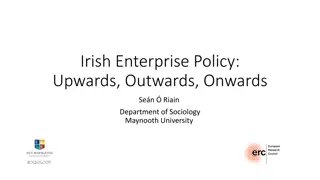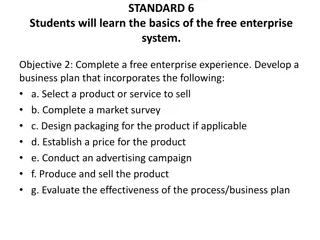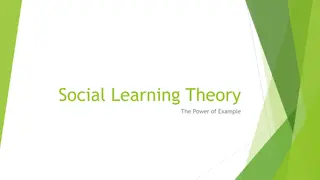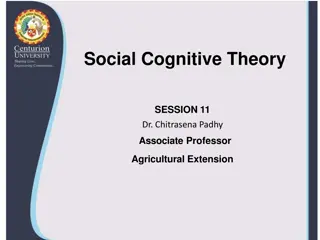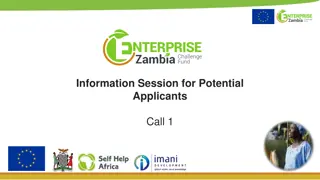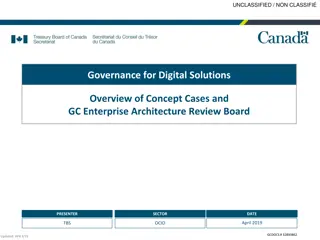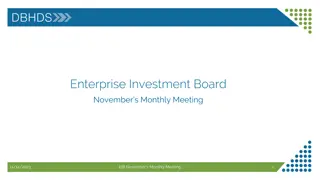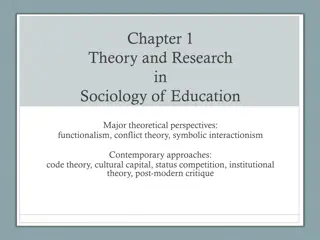Understanding Social Enterprise Cross-Sector Theory by Dr. David Bozward
Explore the origins, definitions, and key theories of social enterprise, including the hybridization concept, Leadbeater's model, and more market-focused approaches. Learn about the impact of social enterprises on society and the unique role they play in combining economic principles with social goals.
Download Presentation

Please find below an Image/Link to download the presentation.
The content on the website is provided AS IS for your information and personal use only. It may not be sold, licensed, or shared on other websites without obtaining consent from the author. Download presentation by click this link. If you encounter any issues during the download, it is possible that the publisher has removed the file from their server.
E N D
Presentation Transcript
Social Enterprise Cross Sector Theory Dr. David Bozward
Learning Goals Definition of social enterprise. Understand the cross-sector theories of social enterprise. Identify popular companies in the health sector and their social impact.
Origins & Early Development Social entrepreneurship (primarily US-led) ASHOKA (USA) - 1980 School for Social Entrepreneurs (UK) - 1997 Schwab Foundation (USA) - 1998 Community Action Network (UK) - 1998 Social enterprise (primarily EU-led) Social Audit Tools - for worker and community co-ops (UK) - 1979 Social Cooperative Law (Italy) - 1991 Social Enterprise Institute (Harvard, US) - 1993 EMES European Research Network (EU) - 1994 Social Enterprise London (UK) - 1998 Social Enterprise Alliance (USA) - 1998 Social Exclusion Unit (UK Government Report) - 1999
UK Definition Social enterprise means an enterprise whose primary objective is to achieve social impact rather than generate profit for owners and stakeholders. It operates in the market through the production of goods and services in an entrepreneurial and innovative way, and uses surpluses mainly to achieve social goals. It is managed in an accountable and transparent way, in particular by involving workers, customers and stakeholders affected by its business activity. See DTI (2002) A Strategy for Social Enterprise, London: HM Treasury, p7.
Cross Sector Theory Hybridisation (Nyssens, 2006:318) " we argue that social enterprises mix the economic principles of market, redistribution and reciprocity, and hybridize their three types of economic exchange so that they work together rather than in isolation from each other." Leadbeater's Model (1997) First theorisation of social entrepreneurship as cross-sector Recognises private and public sector influences Does not see social enterprise as a distinct sector Does this lead to hybrid forms of organisation?
More market focused Cross Sector Theory Private Sector Public Sector B - CSR D Multi Stakeholder C - A More than Profit Non Profit More mission focused Third Sector
Cross-Sector Theory of Social Enterprise Type A Non-Profit Model Public interest outlook, hostility to private sector ownership and equity finance. Between public and third sectors. 'Non-profit' - obtains grants and/or contracts from public sector and third sector organisations - structured to prevent profit and asset transfers. Type B Corporate Social Responsibility Model Suspicious of the third sector as a viable partner in public service delivery and economic development. Between public and private sectors. Corporate social responsibility projects - environmental, ethical or fair trade business - for- profit employee-owned business. Type C More That Profit Model Antipathy to the state (central government); realistic about the state s capacity to oppress minorities. Between private and third sectors. Single or dual stakeholder co-operative, charity trading arm, membership society / association, or a trust that uses trading surpluses to increase social investment. At the overlap of all three sectors. Multi-stakeholder, democratic enterprise using direct and representative democracy to achieve equitable social and economic benefits. Type D (ideal) Multi-Stakeholder Model Replaces public, private and third sector competition with a democratic multi- stakeholder model. Adapted from Ridley-Duff, R. J. (2008) Social Enterprise as a Socially Rational Business , International Journal of Entrepreneurial Behaviour and Research, 14(5): 291-312.
Social Enterprise Factors Company Structure a) Strategic Intention b) Governance Financial a) Total Turnover b) Turnover dedicated to social impact Social Impact a) Interventions b) PR & Policy
NHS England Governance Public Social Strategic Intention The English NHS is controlled by the UK government through the Department of Health (DH), which takes political responsibility for the service. Resource allocation and oversight was delegated to NHS England, an arms-length body, by the Health and Social Care Act 2012. Total Turnover 95bn Social Impact Turnover 100% Interventions The NHS in England deals with over 1 million patients every 36 hours. PR / Policy Best Practice Policy Example
Cross Sector Theory Private Sector Public Sector B - CSR D Multi Stakeholder C - More than Profit A Non Profit Third Sector
Nuffield Health Charity Governance Prevention of sickness by helping people to become and remain fit and healthy; Identification, assessment and containment of health risks; and treatment of health problems. Social Strategic Intention 650.2m Income from the Hospital and Wellbeing s clinical activities; Wellbeing membership Management contracts for wellbeing services Total Turnover 100% Social Impact Turnover 51,300 orthopaedic procedures, reducing patients pain and increasing their mobility; 29,500 general surgical procedures; 16,300 ophthalmic procedures to improve patients sight; and 52,800 MRI scans Interventions None noteworthy PR / Policy
Cancer Research Charity Governance Increase our investment to support the earlier diagnosis of cancer. Increase our research effort in lung, pancreatic, oesophageal cancers and brain tumours to accelerate progress. Discover and develop new tests, surgery and radiotherapy techniques, new drugs, and speed up the pace at which research is translated into benefits for patients. Optimise every individual s chance of beating cancer. Work towards the day when no one in the UK smokes. Give every cancer patient information to know their choices and to join the fight against cancer. Social Strategic Intention 490m Total Turnover 163m Legacies 123m Donations 76m Retail 70m Events 38m Local Groups 100% Social Impact Turnover Fund 4,000 scientists. Continues to fund some of the UK s best cancer research, including 26 new programme grants, 12 translational projects, 17 trials and feasibility studies and 13 fellowships and awards for new investigators. Remain the largest charitable funder of cancer research worldwide. Interventions Helped secure smoke-free legislation across the UK and a ban on sunbeds in England and Wales for under-18s. PR / Policy
British Red Cross Charity Governance Help millions of people prepare for, respond to and recover from all kinds of crises disasters, conflicts and health-related or other personal crisis. Social Strategic Intention 228.4m 106.5m Donations 21.8m Legacies 28.1m Retail 44.0m Contracts and fees 25.1m Grants 2.9m Other income Total Turnover 100% Social Impact Turnover Volunteers and staff treated 32,500 people at more than 7,800 events. Interventions 1) securing inclusion of first aid on the national curriculum and encouraging more schools to teach first aid; 2) driving changes in the asylum system to reduce destitution of people receiving refugee status, and promoting the continued need for legal support for refugees seeking to be reunited with their families; 3) winning policy support at a national and local level for the importance of low level preventative health and social care to allow people to live with dignity and independence where possible in their own home PR / Policy
St John Ambulance Charity Governance Increase the number of adults and young people able to deliver first aid Increase the number of young people participating in St John Ambulance s youth programmes, as well as extending the reach of these to disadvantaged groups Increase awareness of the importance of first aid, encouraging people to acquire first aid skills Maximise St John Ambulance s impact at events. Social Strategic Intention 91.4m Total Turnover First aid training 38.8m (40%) First aid ambulance and transport services 18.7m (19%) First aid provision and youth development 8.3m (9%) First aid products 8.3m (9%) 100% Social Impact Turnover 250,000 people trained in the workplace Interventions 15 million adults were reached with our Save the boy TV campaign PR / Policy
Cross Sector Theory CSR Multi Stakeholder Third Sector
Bupa Governance Private (private company limited by guarantee) Social Strategic Intention Focused program on three pillars: Orphans, Employees and Community. Total Turnover 9.1bn - 628.2M Profit Social Impact Turnover None Stated Interventions Health Care : 22m customers CSR Activities are: Orphans: 2451 Orphans free medical insurance and Day Activity in Saudi Employees: Bupa football & basketball tournament, Bupa weight loss program and Bupa Stairs walk. Community: Health & wellbeing Information, E-Sehaty, and Bupa Global Challenge Initiative. PR / Policy Bupa will harness our expertise to better effect for customers and wider society, taking a greater role in shaping the patient s healthcare journey and working with health systems to shape health policy in the interests of communities.
Boots Governance Private (Walgreens Boots Alliance, Inc.) Social Strategic Intention We believe in making a difference and are proud of the contribution we make to the wellbeing of the communities we serve. Total Turnover 23.4bn (Global) / 1.38bn (UK) Social Impact Turnover 3.9m (UK) Interventions To establish meaningful multi-year partnerships with charitable organisations that share our values of making a difference and our commitment to improving health and wellbeing in the local communities that we serve. To raise over 5 million by 2016 to establish a biobank for colorectal cancer in partnership with the EORTC Charitable Trust. For each principal business to establish partnerships with charitable organisations with supporting activities to improve the health and wellbeing of people within its local community. To make use of our significant consumer reach through our owned and franchise pharmacies as well as the Alphega Pharmacy network with local programmes to deliver health related information and advice to customers and patients. PR / Policy
GSK Governance Private Social Strategic Intention Our strategic priorities grow, deliver, simplify help us work towards our vision, while enhancing business performance and delivering sustainable growth. We focus on understanding the needs of patients, consumers and individual markets so we can channel our research into developing appropriate products. These insights also enable us to adapt our business model to improve availability and affordability. Total Turnover $23bn / $6.6bn profit Social Impact Turnover $221m Interventions We donated medicines valued at 146 million (at cost), including 763 million albendazole tablets to fight lymphatic filariasis and soil-transmitted helminths in 2013 PR / Policy
Astra Zeneca Governance Private Social Strategic Intention Established products Growth platforms Pipeline Total Turnover $26bn / $6.9bn Social Impact Turnover $1.2bn Interventions Through our three patient assistance programmes in the US we donated products valued at an average wholesale price of over $1.05 billion (2012: $1.12 billion). Young Health Programme (YHP) country programme and have 18 programmes under way around the world. With over 480,000 young people directly reached with the skills and information they need to improve their health, we have exceeded our target of reaching a minimum of 300,000 young people by the end of 2013 PR / Policy
Summary We often think of social with only one meaning for the entire sector. Social enterprise is a useful umbrella terms for any (democratic) organisational form / activity where people are not in it for the money but still generate a financial surplus. Social enterprises transcend traditional sector boundaries and have the potential to form a social economy with distinct characteristics. Models and diagrams can help to describe and explain the boundaries of the social economy, and its link to other economic sectors.
References and Reading Alter, K. (2007) Social Enterprise Typology, www.virtueventures.com/typology (version 1.5, published 27th November 2007) CECOP (2006) Social enterprises and worker cooperatives: comparing models of corporate governance and social inclusion , paper to CECOP European Seminar, Manchester, 9th November. Dees, G. (1998) Enterprising Non-Profits: What do you do when traditional sources of funding fall short? , Harvard Business Review, January-February, pp. 54-67. Defourny, J. (2001) Introduction: from third sector to social enterprise in Borzaga, C. and Defourny, J. (eds) The Emergence of Social Enterprise, London: Routledge, pp.1-28. DTI (2002) A Strategy for Success, London: HM Treasury. Leadbeater, C. (1997) The Rise of the Social Entrepreneur, London: Demos. Morgan, G. G. (2008) TheSpirit of Charity , Professorial Lecture, Centre of Individual and Organisation Development, Sheffield Hallam University Nyssens, M., (2006) Social Enterprise at the Crossroads of Market, Public and Civil Society, London: Routledge. Ridley-Duff, R. J. (2008) Social Enterprise as a Socially Rational Business , International Journal of Entrepreneurial Behaviour and Research, 14(5): 291-312. Seanor, P., Bull, M. & Ridley-Duff, R. J. (2007) Contradictions in social enterprise: do they draw in straight lines or circles? , paper to 31st Institute of Small Business and EntrepreneurshipConference, Glasgow, 5th-7th November. Somers, A. (2007) "Blurring boundaries? New Labour, Civil Society, and The Emergence of Social Enterprise", presentation to the 4th Social Entrepreneurship Research Conference, London Southbank University. Spreckley, F. (2008) Social Audit Toolkit (Fourth Edition), St Oswalds Barn: Local Livelihoods Ltd. Westall, A. (2001) Value-Led, Market-Driven: Social Enterprise Solutions to Public Policy Goals, London: IPPR.
Resources and Support Harvard Business School: http://www.hbs.edu/socialenterprise/about/history.html Brief history of social enterprise at a leading US university Social Enterprise Alliance: http://www.se-alliance.org/ The lead organisation advocating for social enterprise in the USA The Social Enterprise Coalition: http://www.socialenterprise.org.uk/ The lead organisation advocating for social enterprise in the UK EMES European Research Network: http://www.emes.net Leading European network of researchers examining Third Sector and Social Enterprise Co-operatives UK: http://www.cooperatives-uk.coop/ One of the founders of Social Enterprise Coalition in the UK. Social Enterprise Magazine: http://www.socialenterprisemag.co.uk/ Popular sectoral magazine. The Social Enterprise Institute: http://www.sml.hw.ac.uk/socialenterprise/ Scottish institute researching social enterprise at Herriot-Watt University Office of the Third Sector: http://www.cabinetoffice.gov.uk/third_sector/social_enterprise/
Cross Sector Theory Private Sector Public Sector B - CSR D Multi Stakeholder A Non Profit C - More than Profit Third Sector


